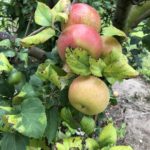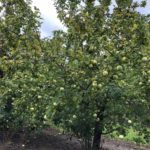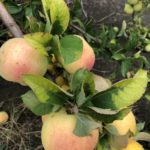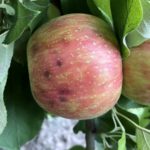Susan Brown of Cornell probably said it best: “The performance and attributes of Honeycrisp are varied and can be grouped under the heading, ‘The good, the bad, and the ugly.’ The ‘good’ refers to a great name for marketing and excellent texture, crispness, and juiciness. The ‘bad’ refers to coloring problems, appearance defects, and susceptibility to an undiagnosed leaf dis- order. The ‘ugly’ refers to bitter pit, scald, soft scald, and a tendency to ferment due to skin permeability problems.” More than 25 years after the release of Honeycrisp, we still don’t have definitive answers.
We are already experiencing numerous reports of Honeycrisp (and other apple) yellows this year (Fig. 1a,b,c). This disorder is a genetic peculiarity of Honeycrisp (and apparently a few other varieties) and is believed to be caused by excessive buildup of carbohydrates in the leaves (Snyder-Leiby and Wang, 2008). Yellowing is often most severe on trees with light crop loads (although the included pictures makes one wonder about that!). The excess carbohydrates that build-up in fruitless limbs are correlated to declining photosynthesis and leaf chlorophyll levels, turning the leaves yellow. Although disconcerting, this yellowing seems to have no detrimental effect on the trees. The occurrence is common and does not seem to impact tree health or performance.
- Fig 1a. Honeycrisp yellows compared with other varieties
- Figure 1b Photo by Janna Beckerman
- Figure 1c Photo by Janna Beckerman
Now, let’s talk briefly about correlation and causality. Relax–It’s not that scary. Correlation between two variables indicates that changes in one variable are associated with changes in the other variable. For us, this means variable 1= crop load and variable 2= yellowing. When we have light crop loads, we associate it with ‘more’ yellowing. Keep in mind that this correlation of light crop loads DOESN’T cause the yellowing, just that they MAY be related. Sometimes these relationships are clear: For example, small dogs(variable 1) usually weigh less(variable 2) than big dogs; more torque and horsepower is associated with a more powerful engine than one with less torque and horsepower.
However, sometimes a correlation is just a correlation. For example, the rooster crows and the sun rises are positively correlated. Does the rooster cause the sun to rise? (Hint: Do not ask the rooster—he’s cocky that way.). Going back to yellowing and crop loads, to actually figure out this and other correlations, you’ll need to perform more experimentation to determine that a relationship is causal instead of correlated.
Also, don’t just assume that you have yellows just because it is Honeycrisp–Be sure! As always, pull out that hand lens to confirm the absence of leafhoppers. No one wants to apply any insecticide unnecessarily—at the same time, no one wants to enable an outbreak of leafhoppers from a misdiagnosis!
But what about bitter pit?
Bitter pit is a physiological disorder characterized by dark sunken lesions at or beneath the fruit surface (Fig. 2). Pits may be observed before harvest (Fig. 3), be present at harvest or, more frequently, become evident after the fruits have been placed in storage. Pits usually appear first at the blossom end of the fruit, but can be observed throughout the fruit. Conditions that favor excessive fruit size make bitter pit worse. Bitter pit has been correlated (there’s that word again!) with drought, nutrient excess (magnesium, nitrogen and potassium), and nutrient deficiency (boron, calcium).
- Fig. 2. Bitter pit after storage. Photo by Janna Beckerman
- Fig. 3. Bitter pit developing about 2 weeks before harvest. Photo by Janna Beckerman.
Managing this problem is more complicated than just spraying x, y or z (Baugher et al. 2017). However, complicated is difficult to implement in the orchard. With that in mind, bitter pit in ‘Honeycrisp’ is best managed by applying high rates of CaCl2 throughout summer. Keep in mind that CaCl2 sprays cannot completely control bitter pit if other factors are less than idea (e.g., crop load, thinning, fruit size, other nutritional issues). As an added bonus, hgher levels of exogenous CaCl2 was found to reduce bitter rot in storage, too (Biggs and Peck, 2015).
Baugher, TA, Marini, R., Schupp, JR, and Watkins, CB. Prediction of Bitter Pit in ‘Honeycrisp’
Apples and Best Management Implications. HortScience 52(10):1368–1374. 2017 https://fruit.wisc.edu/wp-content/uploads/sites/36/2017/11/Prediction-of-Bitter-Pit-in-Honeycrisp.pdf
Biggs, A.R., and Peck, GM. 2015. Managing Bitter Pit in ‘Honeycrisp’ Apples Grown in the Mid-
Atlantic United States with Foliar-applied Calcium Chloride and Some Alternatives. HortScience 25:385-91. http://horttech.ashspublications.org/content/25/3/385.full.pdf
Brown, S. Fargione, M., Merwin, I., and Rosenberger, D. 1999. What we have learned about
new apple varieties. N. Y. Fruit Quarterly 7(1): 7-11.
Snyder-Leiby and Wang, 2008. Role of Crop Load in Chloroplast Ultra-structure and Zonal
Chlorosis, a Physiological Disorder in ‘Honeycrisp’ Apple Trees. HORTSCIENCE 43(6):1819–1822. 2008.
For more info on Honeycrsip: http://citeseerx.ist.psu.edu/viewdoc/download?doi=10.1.1.656.5282&rep=rep1&type=pdf




